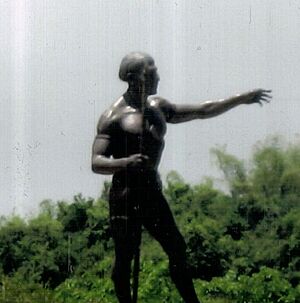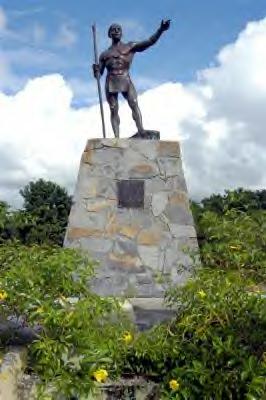Jumacao facts for kids
Jumacao, also known as Jumaca, was an important Taíno leader (called a Cacique) in Puerto Rico. He was born around the 1480s. The area he ruled is now known as Humacao, named after him.
Contents
Taíno Life Before Europeans Arrived
Long before the Spanish arrived, the Taíno people lived in Puerto Rico. They were well-organized and peaceful. Their main challenges sometimes came from the Carib tribes from other islands.
A Cacique was like a chief or governor of a Taíno region. All the Caciques reported to a "Supreme Cacique." During Jumacao's time, the Supreme Cacique was Agüeybaná.
When the Spanish explorer Juan Ponce de León first arrived, Agüeybaná welcomed him. However, this friendship didn't last. The Spanish, known as Conquistadores, began to force the Taíno people into labor and change their way of life.
Taíno Resistance and Revolt
Historical records from Spain tell us about a major event in February 1511. Agüeybaná's brother, Agüeybaná II (also called "The Brave"), along with Urayoan, the Cacique of Añasco, and their men, drowned a Spanish soldier named Diego Salcedo. They watched his body to see if he would come back to life. When he didn't, the Taínos realized that the Spanish were not gods as some believed.
This news spread quickly among the Taíno people. They began a rebellion, attacking some Spanish settlements. After Spanish troops killed Cacique Agüeybaná II, the Spanish government agreed to a peace treaty. However, the Spanish on the island often ignored this treaty. They continued to force Taínos into labor and destroy their villages.
Jumacao's Fight for His People
Cacique Jumacao was special because he was one of the first Taíno leaders to learn how to read and write in Spanish. He used this skill to write a letter to King Charles I of Spain. In his letter, Jumacao complained that the governor of Puerto Rico was not following the peace treaty. He explained that he and other Caciques had become like prisoners. Jumacao also stated that he was responsible for his own actions, showing his independence.
The King was touched by Jumacao's letter and ordered the governor to respect the treaty. However, the local government continued to mistreat the Taínos.
Jumacao, with the help of Cacique Daguao from Naguabo, fought back. They attacked Spanish settlements and burned down the city of Santiago (founded in 1513). This city was near the Daguao River. All its inhabitants were killed. According to one survivor, Ignacio Martinez, the Caciques and their tribes then hid in the mountains of Luquillo. After this, Jumacao was never heard from again.
Jumacao's Lasting Legacy
Today, there is a statue of Cacique Jumacao in the city of Humacao. In 1975, the city honored him by adding a crown to its Municipal Coat of Arms. This crown represents the importance of the Cacique. The city of Humacao also gives out the "Cacique Jumacao Award" to businesses that do well in their recycling programs.
See also
- List of Puerto Ricans
- Agüeybaná
- Agüeybaná II
- List of Taínos
- Arasibo
- Hayuya
- Orocobix
- Tibes Indigenous Ceremonial Center



